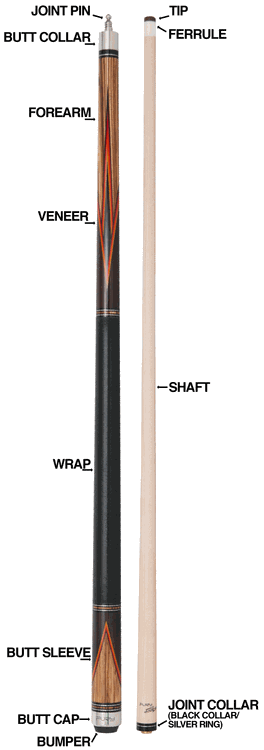Pool Cue Anatomy 101
 If you have found this article to be helpful, we hope you will pass it along to all your friends. If you'd like, you may even link this article on your blog.
If you have found this article to be helpful, we hope you will pass it along to all your friends. If you'd like, you may even link this article on your blog.
We find that if you are a new pool player it's best to know all the different parts of a pool cue. While it may seem like a cue only has two parts, it actually has quite a few different parts. We hope this easy to understand diagram and guide will help you become more familiar with your pool cue.
We'll start from the top of the cue and work our way down.
TIP
The tip is the part of your pool cue that you use to strike the cue ball. It is typically made of leather and is 13mm in size. There are tips that are as small as 11mm and as large as 14mm. Tips also vary in hardness which affects how the cue ball is hit:
- To produce a more powerful hit, you would want to use a harder tip.
- To gain more control over your hit, you would want to use a softer tip.
FERRULE
Right underneath the tip is the ferrule. The ferrule is most often white, but can be black as well. It is used to help reinforce your tip as well as limit the vibrations you'll feel when you shoot. For the pool player just starting out, the ferrule is not something most think about. League players and world champions however, do not want a ferrule that will affect their shot by causing it to be inconsistent.
SHAFT
The shaft is the top and longest half of a two-piece cue. Typically shafts are hand crafted from maple wood, however, you may also find shafts made of graphite or fiberglass. The taper of the shaft, which becomes smaller the closer you get to the tip, and the smooth nature of the wood used for the shaft, help you maintain a consistent shot that allows the cue to glide through your fingers.
JOINT COLLAR
The joint collar is what connects the shaft of the cue to the butt of the cue. It often is black with a silver ring (referred to as ringwork). The joint is one of the most important aspects of the cue, as it is what provides the strength and stability of the cue when you are shooting. A weak joint will completely throw off your shot.
JOINT PIN
The joint pin is at the top of the butt (bottom half) of the cue. There are many different types of pins from a Speed-Loc (only takes a few turns to disassemble the cue) to a Radial (takes several turns to disassemble the cue, which provides more strength and what most advanced players feel is a more consistent shot).
BUTT COLLAR
The butt collar is located directly below the joint pin. It can be made of many different materials, though the most common is stainless steel. The butt color is what helps give a two-piece cue the appearance of being one-piece, like a house cue.
FOREARM
The forearm comes after the butt collar. It is the longest part of the bottom half of the cue. The forearm is usually made of wood and where you will find most of your inlays (designs set into the wood) or overlays (designs which are decals placed on top of the wood). The forearm will have a protective glossy coating which seals it against the typical use and abuse a pool player will put the cue through.
WRAP
Typically in the middle of the bottom half of the cue, below the forearm is the wrap. The wrap helps a pool player get a grip on their cue (and game). It can be made of nylon, Irish linen or imitation and real leather. There are numerous cues that come unwrapped as some players prefer a natural handle to their cue.
BUTT SLEEVE
Below the wrap is the butt sleeve. Like the forearm, the butt sleeve of a pool cue will typically have your inlays or overlays, which will be an extension of the design on the forearm. Inside the butt sleeve, you will most often find an interchangeable weight bolt system, should you choose to make your cue lighter or heavier.
BUTT CAP
The second to last piece of a pool cue is the butt cap. It provides added strength and also is part of the interchangeable weight bolt system.
BUMPER
The very last part of a pool cue is the bumper. It is typically made of rubber and is there to help in absorbing the impact of your shot. It also helps protect the cue for those that may decide to tap a beat while waiting for their next shot.
Now that you know all the parts of a pool cue, which one do you choose? Well, that's all up to your personal preference. Are you looking for a pool cue in a certain price range? Are you looking for one with intricate designs and inlays? Or maybe you want something with a little bit of personality to it.
No matter what type of pool cue you're looking for, CueSight can help! Our warehouse is stocked with thousands of cues ready to be shipped right to your door. Our prices and quality are unmatched anywhere online.
We have a great primer on "How To Buy A Pool Cue" for those looking to purchase their first pool cue.
Please note most of our pool cues over $150 come with a free pool cue case. However, there are some which do not.
